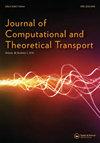对流加热和变达西模式下纳米流体双向流动的输运特征
IF 1.1
4区 工程技术
Q3 MATHEMATICS, APPLIED
Journal of Computational and Theoretical Transport
Pub Date : 2023-09-20
DOI:10.1080/23324309.2023.2257394
引用次数: 0
摘要
摘要研究了Au和TiO2纳米颗粒在受对流加热的旋转效应和变达西现象推动下在Casson流中的性能。由于卡森流变学最能描述哺乳动物血液流动动力学,并且血液在本质上是导电的,因此本研究采用卡森流体模型和磁流体动力学效应来研究血液的双向旋转边界层流动,从而为生物医学行业正确预测和治疗癌症、狭窄等疾病做出重要贡献。纳米粒子的巨大性能使它们非常有用;因此,它们获得了超越传统制冷剂的认可,并被科学家、建模师和研究人员广泛用于通过药物靶向(化疗)等控制和治疗疾病。在三维平面上,假设的导电流体通过科里奥利力适当混合,从而以角速度λ在可变多孔介质上旋转。利用伪谱方法的切比雪夫配点法(chbyshev allocation Method, CCM)对变换后的ode进行求解。分析和讨论了Au和TiO2纳米粒子上的Eckman、Darcy和Biot数等模型参数对各自边界层的响应曲线分布。TiO2纳米粒子在两种速度上均占主导地位,而Au纳米粒子表现出更高的热性能率。达西参数的升高对初级和次级速度的影响是完全相反的。关键词:卡森流体;流动;边界层对流;(德意志联邦共和国/ 1/2023 / STG06 /人民运动联盟/ 02/7)。感谢马来西亚彭亨苏丹大学给予的鼓励和支持。作者已阅读并批准稿件,并声明无利益冲突。本文章由计算机程序翻译,如有差异,请以英文原文为准。
Transport Features on Bidirectional Nanofluid Flow with Convective Heating and Variable Darcy Regime
AbstractThe performance of Au and TiO2 nanoparticles in Casson flow propelled by the rotational effect subject to convective heating and variable Darcy phenomenon is presented. As a means to contribute significantly to the biomedical industry for proper prediction and treatment of diseases like cancer, stenosis, et cetera, the Casson fluid model and magnetohydrodynamic effect are employed in this study to investigate the bidirectional-rotating boundary layer flow of blood since Casson rheology best describe the mammalian blood flow dynamics and that blood is electrically conducting in nature. The enormous performance of nanoparticles made them extremely useful; hence, they gained recognition over the conventional refrigerants and were widely used by scientists, modelers, and researchers for controlling and treating diseases via drug targeting (chemotherapy), etc. In the three-dimensional plane, the assumed electrically conducting fluid conveying nanoparticles is properly mixed through the Coriolis force, thus rotating with angular velocity λ across the variable porous medium. A numerical tool, Chebyshev Collocation Method (CCM) with pseudo-spectral approach, is deployed on the resulting transformed ODEs. Profile distributions of respective boundary layers to distinct responses of model parameters, including the Eckman, Darcy, and Biot numbers on Au and TiO2 nanoparticles, are analyzed and discussed. The dominance of TiO2 nanoparticles on both velocities is revealed, while Au nanoparticles demonstrated a higher thermal performance rate. A rise in the Darcy parameter has a diametrically opposed behavior on the primary and secondary velocities.Keywords: Casson fluidMHDrotationboundary layer flowconvective AcknowledgmentsThe authors would like to thank the Ministry of Higher Education for providing financial support under Fundamental research grant No. (FRGS/1/2023/STG06/UMP/02/7). Appreciation also goes to Universiti Malaysia Pahang Al-Sultan Abdullah for encouragement and support.Disclosure statementThe authors read and approved the manuscript, in addition declared no conflict of interest.
求助全文
通过发布文献求助,成功后即可免费获取论文全文。
去求助
来源期刊

Journal of Computational and Theoretical Transport
Mathematics-Mathematical Physics
CiteScore
1.30
自引率
0.00%
发文量
15
期刊介绍:
Emphasizing computational methods and theoretical studies, this unique journal invites articles on neutral-particle transport, kinetic theory, radiative transfer, charged-particle transport, and macroscopic transport phenomena. In addition, the journal encourages articles on uncertainty quantification related to these fields. Offering a range of information and research methodologies unavailable elsewhere, Journal of Computational and Theoretical Transport brings together closely related mathematical concepts and techniques to encourage a productive, interdisciplinary exchange of ideas.
 求助内容:
求助内容: 应助结果提醒方式:
应助结果提醒方式:


